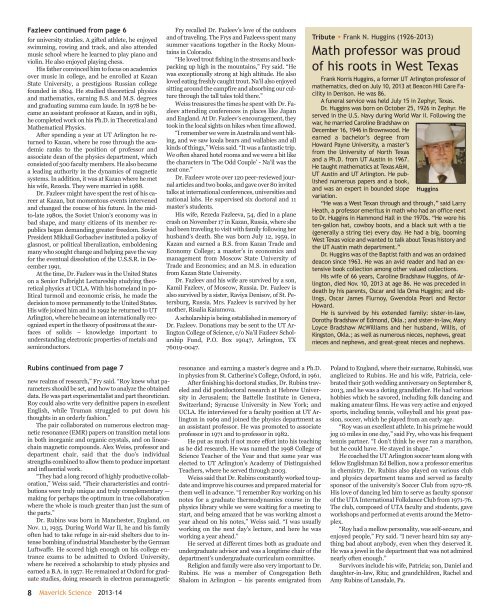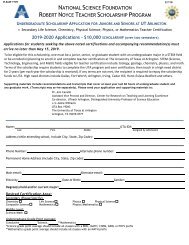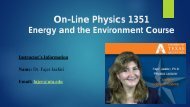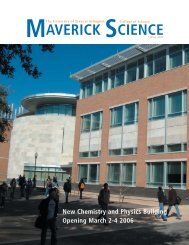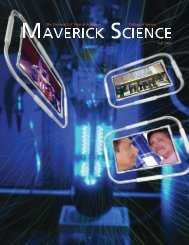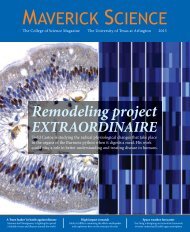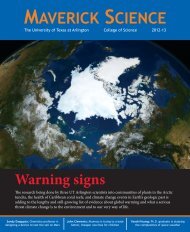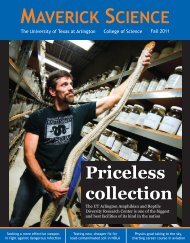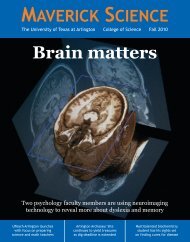Maverick Science mag 2013-14
Create successful ePaper yourself
Turn your PDF publications into a flip-book with our unique Google optimized e-Paper software.
Fazleev continued from page 6<br />
for university studies. A gifted athlete, he enjoyed<br />
swimming, rowing and track, and also attended<br />
music school where he learned to play piano and<br />
violin. He also enjoyed playing chess.<br />
His father convinced him to focus on academics<br />
over music in college, and he enrolled at Kazan<br />
State University, a prestigious Russian college<br />
founded in 1804. He studied theoretical physics<br />
and mathematics, earning B.S. and M.S. degrees<br />
and graduating summa cum laude. In 1978 he became<br />
an assistant professor at Kazan, and in 1981,<br />
he completed work on his Ph.D. in Theoretical and<br />
Mathematical Physics.<br />
After spending a year at UT Arlington he returned<br />
to Kazan, where he rose through the academic<br />
ranks to the position of professor and<br />
associate dean of the physics department, which<br />
consisted of 500 faculty members. He also became<br />
a leading authority in the dynamics of <strong>mag</strong>netic<br />
systems. In addition, it was at Kazan where he met<br />
his wife, Rezeda. They were married in 1988.<br />
Dr. Fazleev might have spent the rest of his career<br />
at Kazan, but momentous events intervened<br />
and changed the course of his future. In the midto-late<br />
1980s, the Soviet Union’s economy was in<br />
bad shape, and many citizens of its member republics<br />
began demanding greater freedom. Soviet<br />
President Mikhail Gorbachev instituted a policy of<br />
glasnost, or political liberalization, emboldening<br />
many who sought change and helping pave the way<br />
for the eventual dissolution of the U.S.S.R. in December<br />
1991.<br />
At the time, Dr. Fazleev was in the United States<br />
on a Senior Fulbright Lectureship studying theoretical<br />
physics at UCLA. With his homeland in political<br />
turmoil and economic crisis, he made the<br />
decision to move permanently to the United States.<br />
His wife joined him and in 1992 he returned to UT<br />
Arlington, where he became an internationally recognized<br />
expert in the theory of positrons at the surfaces<br />
of solids – knowledge important to<br />
understanding electronic properties of metals and<br />
semiconductors.<br />
Fry recalled Dr. Fazleev’s love of the outdoors<br />
and of traveling. The Frys and Fazleevs spent many<br />
summer vacations together in the Rocky Mountains<br />
in Colorado.<br />
“He loved trout fishing in the streams and backpacking<br />
up high in the mountains,” Fry said. “He<br />
was exceptionally strong at high altitude. He also<br />
loved eating freshly caught trout. Na’il also enjoyed<br />
sitting around the campfire and absorbing our culture<br />
through the tall tales told there.”<br />
Weiss treasures the times he spent with Dr. Fazleev<br />
attending conferences in places like Japan<br />
and England. At Dr. Fazleev’s encouragement, they<br />
took in the local sights on hikes when time allowed.<br />
“I remember we were in Australia and went hiking,<br />
and we saw koala bears and wallabies and all<br />
kinds of things,” Weiss said. “It was a fantastic trip.<br />
We often shared hotel rooms and we were a bit like<br />
the characters in ‘The Odd Couple’ - Na’il was the<br />
neat one.”<br />
Dr. Fazleev wrote over 120 peer-reviewed journal<br />
articles and two books, and gave over 80 invited<br />
talks at international conferences, universities and<br />
national labs. He supervised six doctoral and 11<br />
master’s students.<br />
His wife, Rezeda Fazleeva, 54, died in a plane<br />
crash on November 17 in Kazan, Russia, where she<br />
had been traveling to visit with family following her<br />
husband’s death. She was born July 12, 1959, in<br />
Kazan and earned a B.S. from Kazan Trade and<br />
Economy College; a master’s in economics and<br />
management from Moscow State University of<br />
Trade and Economics; and an M.S. in education<br />
from Kazan State University.<br />
Dr. Fazleev and his wife are survived by a son,<br />
Kamil Fazleev, of Moscow, Russia. Dr. Fazleev is<br />
also survived by a sister, Raviya Denisov, of St. Petersburg,<br />
Russia. Mrs. Fazleev is survived by her<br />
mother, Risalia Kaiumova.<br />
A scholarship is being established in memory of<br />
Dr. Fazleev. Donations may be sent to the UT Arlington<br />
College of <strong>Science</strong>, c/o Na’il Fazleev Scholarship<br />
Fund, P.O. Box 19047, Arlington, TX<br />
76019-0047.<br />
Tribute w Frank N. Huggins (1926-<strong>2013</strong>)<br />
Math professor was proud<br />
of his roots in West Texas<br />
Frank Norris Huggins, a former UT Arlington professor of<br />
mathematics, died on July 10, <strong>2013</strong> at Beacon Hill Care Facility<br />
in Denison. He was 86.<br />
A funeral service was held July 15 in Zephyr, Texas.<br />
Dr. Huggins was born on October 25, 1926 in Zephyr. He<br />
served in the U.S. Navy during World War II. Following the<br />
war, he married Caroline Bradshaw on<br />
December 16, 1946 in Brownwood. He<br />
earned a bachelor’s degree from<br />
Howard Payne University, a master’s<br />
from the University of North Texas<br />
and a Ph.D. from UT Austin in 1967.<br />
He taught mathematics at Texas A&M,<br />
UT Austin and UT Arlington. He published<br />
numerous papers and a book,<br />
and was an expert in bounded slope<br />
variation.<br />
Huggins<br />
“He was a West Texan through and through,” said Larry<br />
Heath, a professor emeritus in math who had an office next<br />
to Dr. Huggins in Hammond Hall in the 1970s. “He wore his<br />
ten-gallon hat, cowboy boots, and a black suit with a tie<br />
(generally a string tie) every day. He had a big, booming<br />
West Texas voice and wanted to talk about Texas history and<br />
the UT Austin math department.”<br />
Dr. Huggins was of the Baptist faith and was an ordained<br />
deacon since 1963. He was an avid reader and had an extensive<br />
book collection among other valued collections.<br />
His wife of 66 years, Caroline Bradshaw Huggins, of Arlington,<br />
died Nov. 10, <strong>2013</strong> at age 86. He was preceded in<br />
death by his parents, Oscar and Ida Oma Huggins; and siblings,<br />
Oscar James Flurnoy, Gwendola Pearl and Rector<br />
Howard.<br />
He is survived by his extended family: sister-in-law,<br />
Dorothy Bradshaw of Edmond, Okla.; and sister-in-law, Mary<br />
Loyce Bradshaw McWilliams and her husband, Willis, of<br />
Kingston, Okla.; as well as numerous nieces, nephews, great<br />
nieces and nephews, and great-great nieces and nephews.<br />
Rubins continued from page 7<br />
new realms of research,” Fry said. “Roy knew what parameters<br />
should be set, and how to analyze the obtained<br />
data. He was part experimentalist and part theoretician.<br />
Roy could also write very definitive papers in excellent<br />
English, while Truman struggled to put down his<br />
thoughts in an orderly fashion.”<br />
The pair collaborated on numerous electron <strong>mag</strong>netic<br />
resonance (EMR) papers on transition metal ions<br />
in both inorganic and organic crystals, and on linearchain<br />
<strong>mag</strong>netic compounds. Alex Weiss, professor and<br />
department chair, said that the duo’s individual<br />
strengths combined to allow them to produce important<br />
and influential work.<br />
“They had a long record of highly productive collaboration,”<br />
Weiss said. “Their characteristics and contributions<br />
were truly unique and truly complementary —<br />
making for perhaps the optimum in true collaboration<br />
where the whole is much greater than just the sum of<br />
the parts.”<br />
Dr. Rubins was born in Manchester, England, on<br />
Nov. 11, 1935. During World War II, he and his family<br />
often had to take refuge in air-raid shelters due to intense<br />
bombing of industrial Manchester by the German<br />
Luftwaffe. He scored high enough on his college entrance<br />
exams to be admitted to Oxford University,<br />
where he received a scholarship to study physics and<br />
earned a B.A. in 1957. He remained at Oxford for graduate<br />
studies, doing research in electron para<strong>mag</strong>netic<br />
8 <strong>Maverick</strong> <strong>Science</strong> <strong>2013</strong>-<strong>14</strong><br />
resonance and earning a master’s degree and a Ph.D.<br />
in physics from St. Catherine’s College, Oxford, in 1961.<br />
After finishing his doctoral studies, Dr. Rubins traveled<br />
and did postdoctoral research at Hebrew University<br />
in Jerusalem; the Battelle Institute in Geneva,<br />
Switzerland; Syracuse University in New York; and<br />
UCLA. He interviewed for a faculty position at UT Arlington<br />
in 1969 and joined the physics department as<br />
an assistant professor. He was promoted to associate<br />
professor in 1971 and to professor in 1982.<br />
He put as much if not more effort into his teaching<br />
as he did research. He was named the 1998 College of<br />
<strong>Science</strong> Teacher of the Year and that same year was<br />
elected to UT Arlington’s Academy of Distinguished<br />
Teachers, where he served through 2003.<br />
Weiss said that Dr. Rubins constantly worked to update<br />
and improve his courses and prepared material for<br />
them well in advance. “I remember Roy working on his<br />
notes for a graduate thermodynamics course in the<br />
physics library while we were waiting for a meeting to<br />
start, and being amazed that he was working almost a<br />
year ahead on his notes,” Weiss said. “I was usually<br />
working on the next day’s lecture, and here he was<br />
working a year ahead.”<br />
He served at different times both as graduate and<br />
undergraduate advisor and was a longtime chair of the<br />
department’s undergraduate curriculum committee.<br />
Religion and family were also very important to Dr.<br />
Rubins. He was a member of Congregation Beth<br />
Shalom in Arlington – his parents emigrated from<br />
Poland to England, where their surname, Rubinski, was<br />
anglicized to Rubins. He and his wife, Patricia, celebrated<br />
their 50th wedding anniversary on September 8,<br />
<strong>2013</strong>, and he was a doting grandfather. He had various<br />
hobbies which he savored, including folk dancing and<br />
making amateur films. He was very active and enjoyed<br />
sports, including tennis, volleyball and his great passion,<br />
soccer, which he played from an early age.<br />
“Roy was an excellent athlete. In his prime he would<br />
jog 10 miles in one day,” said Fry, who was his frequent<br />
tennis partner. “I don’t think he ever ran a marathon,<br />
but he could have. He stayed in shape.”<br />
He coached the UT Arlington soccer team along with<br />
fellow Englishman Ed Bellion, now a professor emeritus<br />
in chemistry. Dr. Rubins also played on various club<br />
and physics department teams and served as faculty<br />
sponsor of the university’s Soccer Club from 1970-78.<br />
His love of dancing led him to serve as faculty sponsor<br />
of the UTA International Folkdance Club from 1971-76.<br />
The club, composed of UTA faculty and students, gave<br />
workshops and performed at events around the Metroplex.<br />
“Roy had a mellow personality, was self-secure, and<br />
enjoyed people,” Fry said. “I never heard him say anything<br />
bad about anybody, even when they deserved it.<br />
He was a jewel in the department that was not admired<br />
nearly often enough.”<br />
Survivors include his wife, Patricia; son, Daniel and<br />
daughter-in-law, Rita; and grandchildren, Rachel and<br />
Amy Rubins of Lansdale, Pa.


